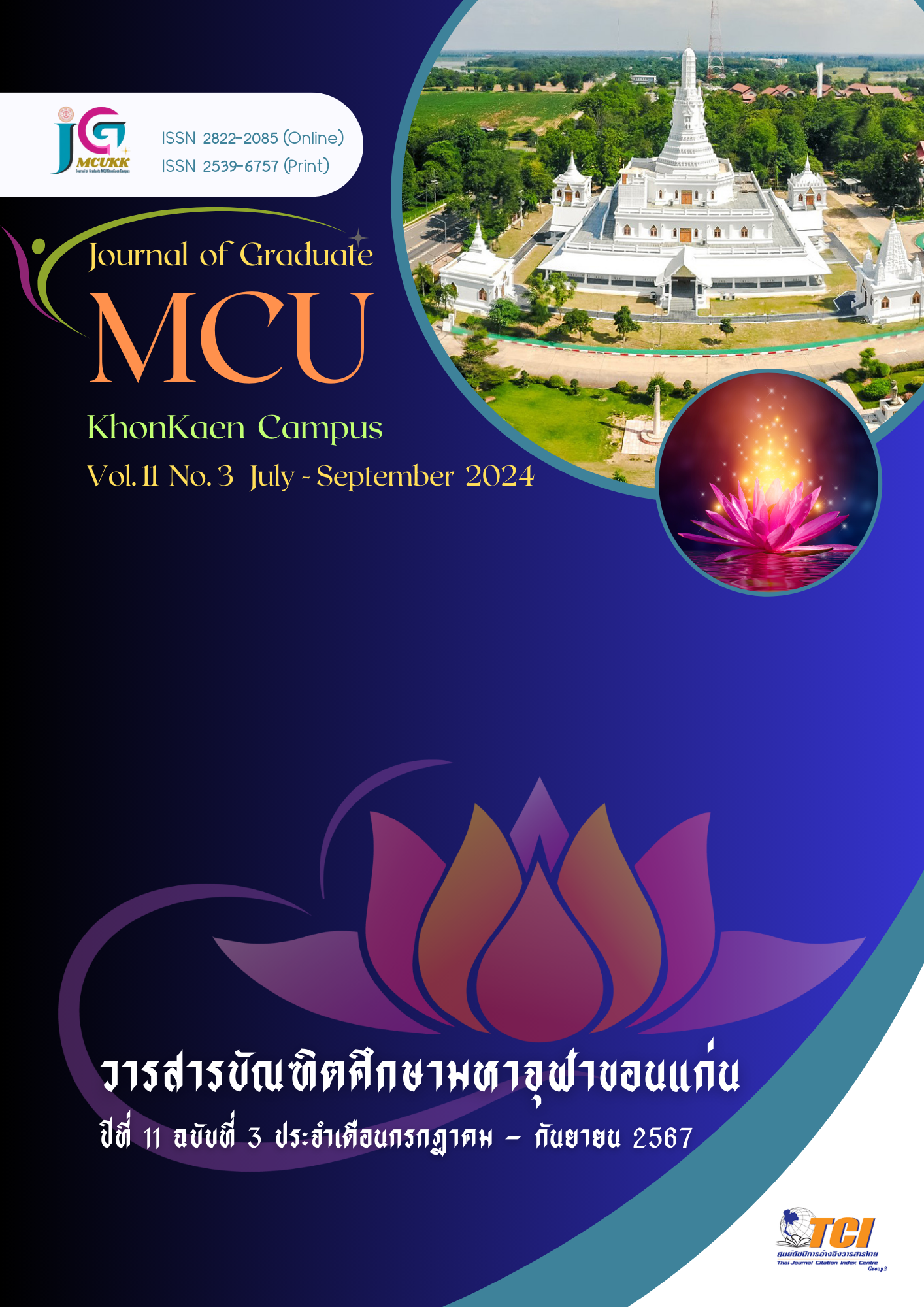การบริหารสถานศึกษาตามหลักพรหมวิหาร 4 ในการสร้างแรงจูงใจ ในการปฏิบัติงานของบุคลากรทางการศึกษา กลุ่มเครือข่ายพัฒนาการศึกษาที่ 8 สำนักงานเขตพื้นที่การศึกษาประถมศึกษาขอนแก่น เขต 1
Main Article Content
บทคัดย่อ
ผลการวิจัยพบว่า
1) การบริหารสถานศึกษาตามหลักพรหมวิหาร 4 ในการสร้างแรงจูงใจในการปฏิบัติงานของบุคลากรทางการศึกษา กลุ่มเครือข่ายพัฒนาการศึกษาที่ 8 สำนักงานเขตพื้นที่การศึกษาประถมศึกษาขอนแก่น เขต 1 โดยภาพรวมรายด้านอยู่ในระดับมากเรียงตามลำดับจากมากไปน้อย ได้แก่ ด้านการสร้างแรงจูงใจตามหลักอุเบกขา ด้านการสร้างแรงจูงใจตามหลักมุฑิตา ด้านการสร้างแรงจูงใจตามหลักเมตตา และด้านการสร้างแรงจูงใจตามหลักกรุณาตามลำดับ
2) แนวทางการบริหารสถานศึกษาตามหลักพรหมวิหาร 4 ในการสร้างแรงจูงใจในการปฏิบัติงานของบุคลากรทางการศึกษา กลุ่มเครือข่ายพัฒนาการศึกษาที่ 8 สำนักงานเขตพื้นที่การศึกษาประถมศึกษาขอนแก่น เขต 1 ผู้บริหารเปิดโอกาสให้ผู้ใต้บังคับบัญชาสามารถรู้ถึงสิทธิ สถานภาพในการปฏิบัติงานของตน พร้อมทั้งมอบหมายงานด้วยความเสมอภาค ตามความเหมาะสมของงาน ให้กำลังใจในการปฏิบัติงานของผู้ใต้บังคับบัญชา ส่งเสริมผู้ใต้บังคับบัญชาให้มีการพัฒนาตำแหน่งงานที่สูงขึ้นหรือพัฒนาตนเองอยู่เสมอ สร้างความยั่งยืนของอาชีพและองค์กรผู้บริหารสร้างเจตคติที่ดีต่อการปฏิบัติงานของผู้ใต้บังคับบัญชาและจัดสภาพแวดล้อมให้เอื้อต่อการปฏิบัติงาน
Article Details

อนุญาตภายใต้เงื่อนไข Creative Commons Attribution-NonCommercial-NoDerivatives 4.0 International License.
เอกสารอ้างอิง
ดนัย ไชยโยธา. (2544). พจนานุกรมพุทธศาสตร์. กรุงเทพฯ: โอเอส พริ้นติ้ง เฮาส์.
ธนพรรธ อนุเวช และ พชรวิทย์ จันทร์ศิริสิร. (2564). แนวทางการสร้างเสริมแรงจูงใจในการปฏิบัติงานของครูในสังกัดสำนักงานเขตพื้นที่การศึกษามัธยมศึกษาร้อยเอ็ด. วารสารมหาจุฬานาครทรรศน์, 8(7), 185-198.
บุญชม ศรีสะอาด (2535). การวิจัยเบื้องต้น. (พิมพ์ครั้งที่ 2). กรุงเทพฯ: สุวีริยา สาส์น.
บุญญาพงษ์ ดวงมาลย์, พระครูปลัดบุญช่วย โชติวํโส และ สุนทร สายคํา. (2564). การพัฒนาภาวะผู้นําการเปลี่ยนแปลงของผู้บริหารสถานศึกษา ตามหลักพรหมวิหาร 4 สังกัดสํานักงานเขตพื้นที่การศึกษาประถมศึกษาขอนแก่น เขต 1. Journal of Modern Learning Development, 6(1),
-262.
พงษ์ศักดิ์ บุบพิ, พระครูปลัดบุญช่วย โชติวํโส และ สมบัติ รัตนคร. (2565). แนวทางการพัฒนาภาวะผู้นำ การเปลี่ยนแปลงตามหลักพรหมมวิหาร 4 ของผู้บริหารสถานศึกษาในสังกัดสำนักงานเขตพื้นที่การศึกษาประถมศึกษา เขต 4. Journal of Modern Learning Development, 7(6), 92-103.
พระราชบัญญัติการศึกษาแห่งชาติ แก้ไขเพิ่มเติม (ฉบับที่ 2). (2545, 19 ธันวาคม). ราชกิจจานุเบกษา เล่มที่ 119 ตอนที่ 123 ก, หน้า 4.
วรยุทธ พลศรี, พระครูปลัดบุญช่วย โชติวํโส และ สุนทร สายคำ. (2565). แนวทางการพัฒนาคุณลักษณะ ผู้บริหารตามหลักพรหมวิหาร 4 สังกัดสำนักงานเขตพื้นที่การศึกษาประถมศึกษาชัยภูมิ เขต 2. Journal of Modern Learning Development, 7(6), 315-325.
สำนักงานคณะกรรมการการศึกษาขั้นพื้นฐาน. (2563). นโยบายสำนักงานคณะกรรมการการศึกษาขั้นพื้นฐาน ปีงบประมาณ พ.ศ.2563. กลุ่มวิจัยและพัฒนานโยบาย: สำนักนโยบายและแผนการศึกษาขั้นพื้นฐาน.
อรสา เพชรนุ้ย. (2560). การศึกษาแรงจูงใจในการปฏิบัติงานของครูในโรงเรียน สังกัดสำนักงานเขตพื้นที่การศึกษาประถมศึกษาสุราษฎร์ธานี เขต 2. (วิทยานิพนธ์ปริญญามหาบัณฑิต). สุราษฎรธานี: มหาวิทยาลัยราชภัฏสุราษฎรธานี.

